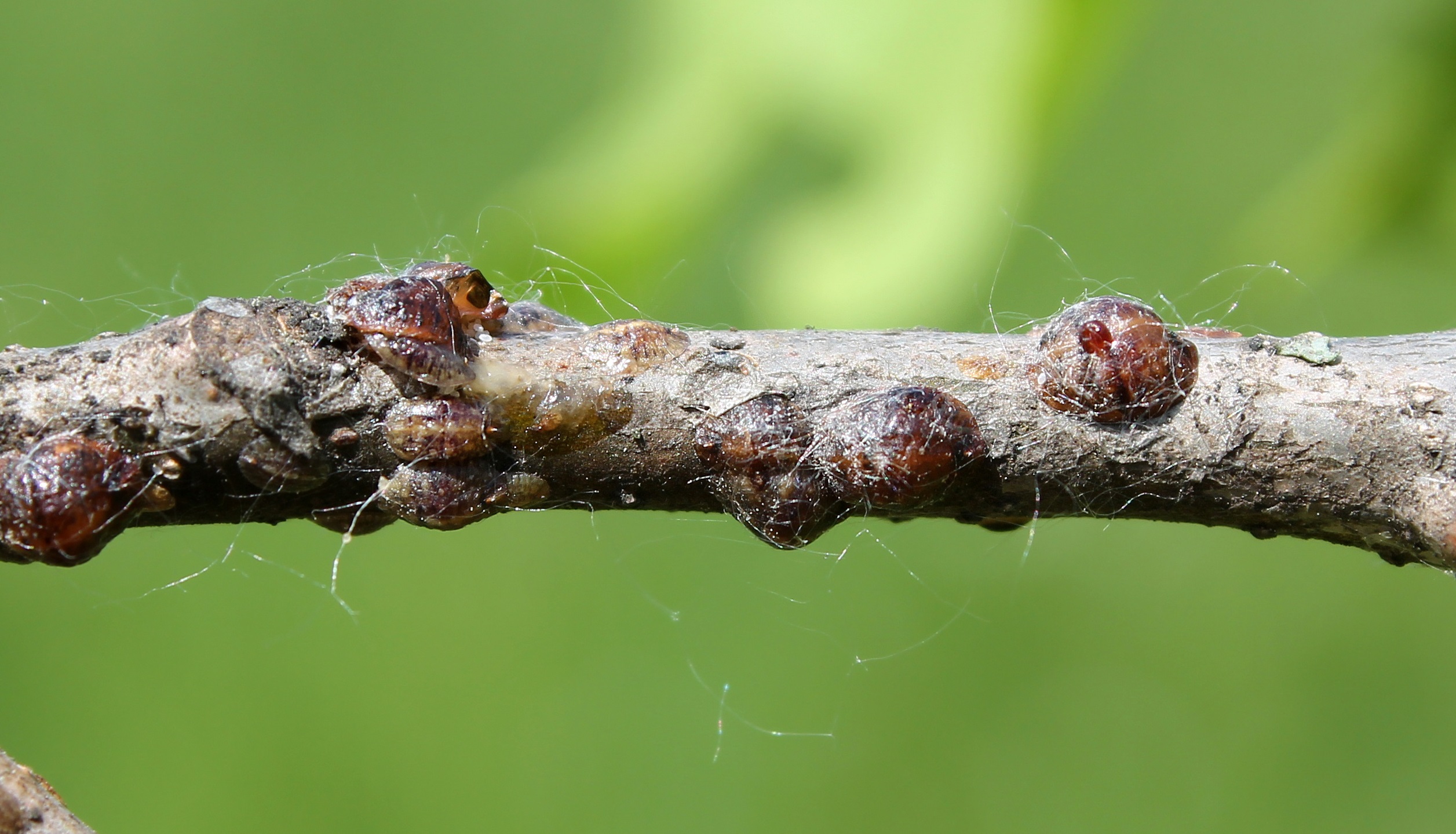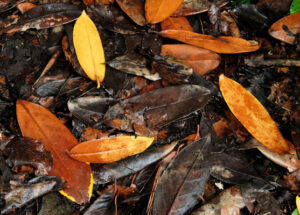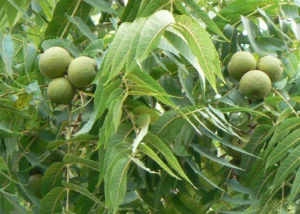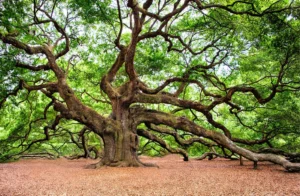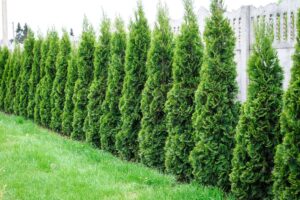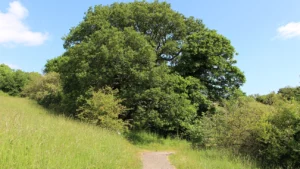A Comprehensive Guide of Types of Tree Insects
Trees are vital to our ecosystem, providing oxygen, shelter, and beauty. However, they are often vulnerable to a variety of insects that can cause significant damage. Understanding the types of tree insects, the damage they cause, and how to protect trees from infestations is critical to maintaining healthy landscapes. This article will provide detailed information on tree insects, how they damage trees, and methods to protect them.
Types of Tree Insects
Tree insects come in a wide variety, each with its own mode of attack and preferences for specific tree species. Here’s a breakdown of the most common types:
| Insect Type | Species Examples | Damage Type | Preferred Trees |
|---|---|---|---|
| Borers | Emerald Ash Borer, Pine Beetles | Bore into trunks, disrupt nutrient flow | Ash, Pine, Oak |
| Sap Suckers | Aphids, Scale Insects, Whiteflies | Drain sap from leaves and stems | Maple, Citrus, Oak |
| Leaf Chewers | Caterpillars, Japanese Beetles, Sawflies | Chew and defoliate leaves | Oak, Elm, Birch |
| Gall Makers | Gall Wasps, Gall Midges | Cause abnormal growths (galls) | Oak, Maple |
| Root Feeders | Root Weevils, Beetle Larvae | Attack roots, weaken tree stability | Conifers, Deciduous trees |
| Bark Beetles | Mountain Pine Beetle, Southern Pine Beetle | Tunnel into bark, carry pathogens | Pine, Spruce |
1. Borers
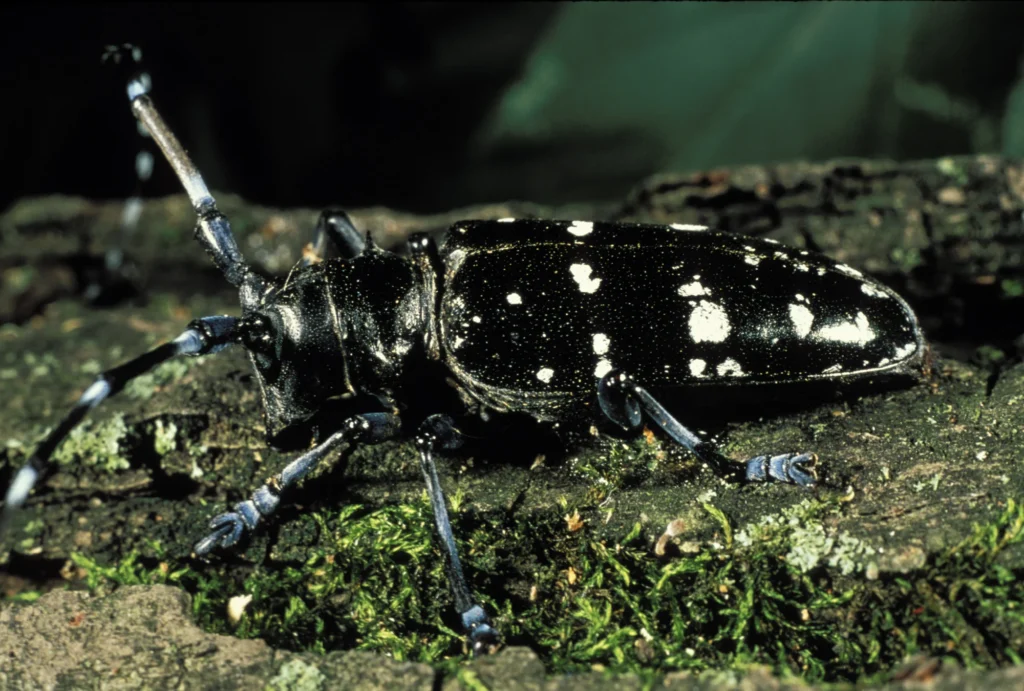
Description:
Borers are a group of tree insects that include various species such as the Emerald Ash Borer, Pine Beetles, and Bronze Birch Borer. These insects are particularly destructive because they bore into the tree’s trunk, branches, or roots. They are known for targeting weakened or stressed trees, but some species, like the Emerald Ash Borer, can also attack healthy trees.
How They Damage Trees:
Borers lay their eggs on or inside the bark of trees. Once the larvae hatch, they tunnel through the tree’s inner layers, specifically the cambium and xylem, which are responsible for transporting water and nutrients. This disrupts the tree’s vascular system, starving it of nutrients and water, leading to dieback, weakened structure, and eventually, death. The damage caused by borers often goes unnoticed until it is too late, as the early stages of infestation are internal and hidden.
Signs of Infestation:
- Holes in the bark (often in a D-shape for Emerald Ash Borer).
- Sawdust-like material (frass) around the base of the tree.
- Canopy thinning and branch dieback.
- Vertical splits in the bark.
How to Protect Trees from Borers:
- Preventative Treatments: Healthy trees are less susceptible to borer infestations, so ensure proper watering, mulching, and fertilization.
- Tree Injections: Systemic insecticides like Imidacloprid can be injected into the tree to kill larvae feeding inside.
- Pheromone Traps: These traps can be used to lure and monitor adult borer populations.
Natural Remedies and Treatments:
- Beneficial Nematodes: These microscopic organisms can be introduced into the soil to attack borer larvae.
- Neem Oil: Works as a natural deterrent, preventing adult borers from laying eggs on the bark.
2. Sap Suckers
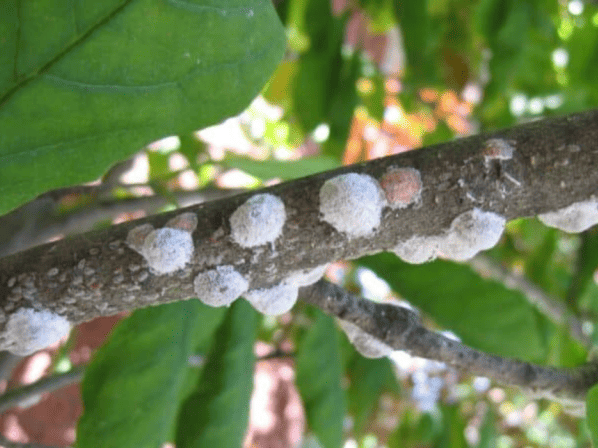
Description:
Sap suckers, including aphids, scale insects, and whiteflies, feed by piercing tree tissues and sucking out the sap. These insects primarily target leaves, stems, and branches, weakening the tree over time by depleting it of essential nutrients. Sap suckers reproduce quickly and can cause large infestations in a short period, which can be particularly damaging to young trees and those under environmental stress.
How They Damage Trees:
When sap suckers feed on a tree, they disrupt the flow of nutrients within the plant. Over time, this nutrient loss weakens the tree, leading to poor growth, yellowing or curling of leaves, and in some cases, stunted development. The feeding process also leaves the tree vulnerable to secondary infections, as the piercing wounds provide an entry point for diseases and pathogens. Additionally, many sap-sucking insects excrete a sticky substance called honeydew, which encourages the growth of sooty mold on the tree’s surface.
Signs of Infestation:
- Sticky residue on leaves (honeydew).
- Black, sooty mold developing on the tree’s surface.
- Yellowing, curling, or wilting of leaves.
- Presence of small insects clustered on leaves or stems.
How to Protect Trees from Sap Suckers:
- Regular Monitoring: Check for the early signs of sticky honeydew or sooty mold.
- Natural Predators: Introduce ladybugs, lacewings, and parasitic wasps, which naturally feed on aphids and scale insects.
- Insecticidal Soap: Spray trees with insecticidal soap or neem oil to suffocate sap-sucking insects.
Natural Remedies and Treatments:
- Neem Oil: Works well against aphids and other sap-sucking insects by disrupting their feeding and life cycle.
- Horticultural Oils: These oils smother the insects and can be applied during dormant seasons to control overwintering populations.
3. Leaf Chewers
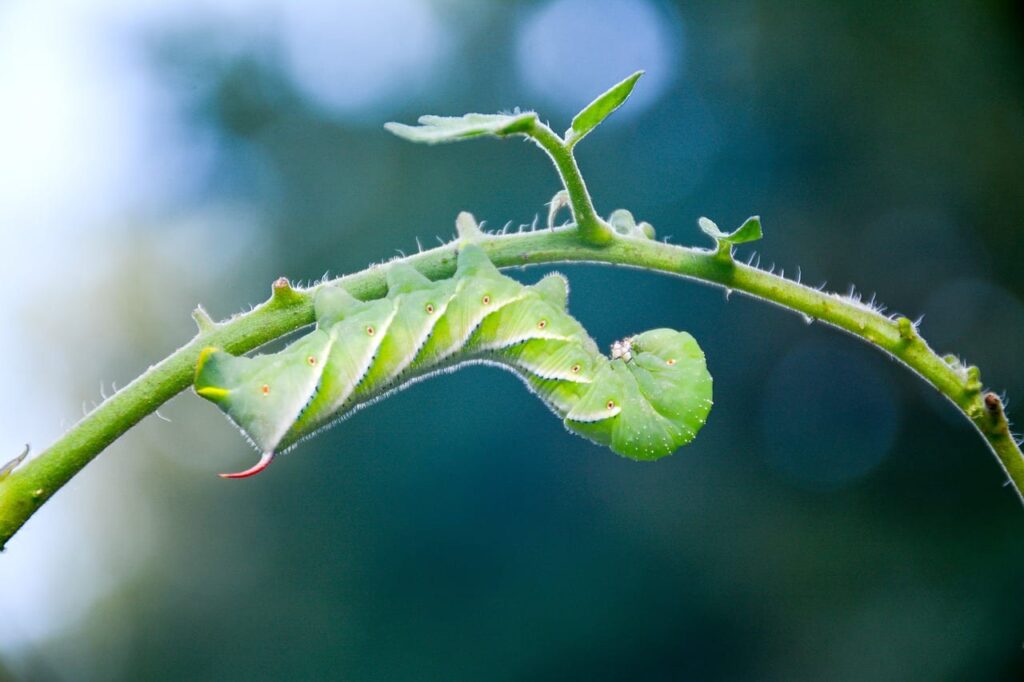
Description:
Leaf chewers such as caterpillars, Japanese beetles, and sawflies are common tree pests that consume leaves, sometimes leaving behind only the leaf veins. While occasional chewing may not severely harm a tree, large infestations can strip a tree of its leaves, severely impacting its ability to photosynthesize and grow.
How They Damage Trees:
Leaf chewers primarily feed on the foliage of trees. The most common culprits are caterpillars (like the Gypsy Moth caterpillar), beetles (like the Japanese Beetle), and sawflies. These insects consume entire leaves or parts of them, leading to defoliation. If a tree loses too many leaves, it cannot produce the energy it needs through photosynthesis, weakening the tree and making it more susceptible to other stressors such as drought, disease, and additional insect infestations.
Signs of Infestation:
- Holes or missing parts of leaves.
- Skeletonized leaves where only the veins remain.
- Clusters of larvae or beetles feeding on foliage.
- Browning and premature leaf drop.
How to Protect Trees from Leaf Chewers:
- Regular Pruning: Remove branches with infestations to reduce populations and prevent further spread.
- Natural Predators: Attract birds or introduce beneficial insects such as parasitic wasps that target leaf chewers.
- Insecticides: Apply foliar sprays such as Bifenthrin or Carbaryl during periods of active feeding to control populations.
Natural Remedies and Treatments:
- Bacillus thuringiensis (Bt): This naturally occurring bacterium can be used to control caterpillar infestations. When ingested, it paralyzes the insect’s digestive system, causing death.
- Neem Oil: An effective natural solution that disrupts feeding patterns and prevents larvae from maturing.
4. Gall Makers
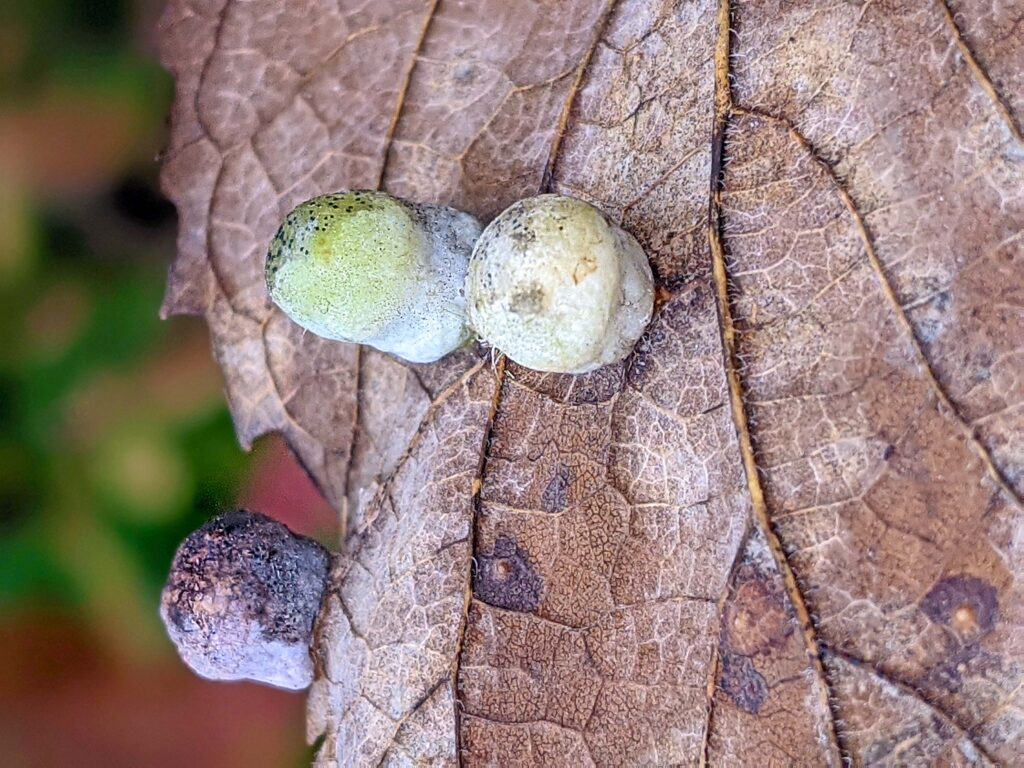
Description:
Gall makers, including gall wasps and gall midges, are a unique group of tree insects that induce the formation of abnormal growths known as galls on leaves, stems, and branches. These growths serve as both habitat and food source for the developing larvae.
How They Damage Trees:
Gall makers inject a chemical into the tree’s tissue, causing the plant to grow galls. Inside these galls, the insect larvae develop, feeding on the surrounding plant tissue. While galls are not typically fatal to trees, they can reduce the tree’s vigor by disrupting normal growth patterns and reducing aesthetic appeal. In severe cases, heavy gall formation can lead to leaf drop, stunted growth, and reduced photosynthetic efficiency.
Signs of Infestation:
- Abnormal growths (galls) on leaves, stems, or branches.
- Discoloration or swelling in affected areas.
- Premature leaf drop in severe cases.
How to Protect Trees from Gall Makers:
- Prune Affected Areas: Remove and destroy galled branches to reduce future infestations.
- Promote Tree Health: Healthy trees are better able to tolerate gall formation, so provide proper watering and fertilization.
- Natural Predators: Encourage natural predators, such as parasitic wasps, to control gall wasp populations.
Natural Remedies and Treatments:
- Insecticidal Soap: Can be used to treat gall-forming insects when they are still in the early larval stage.
- Neem Oil: Helps to disrupt the development of gall-forming insects and can prevent further gall formation.
5. Root Feeders
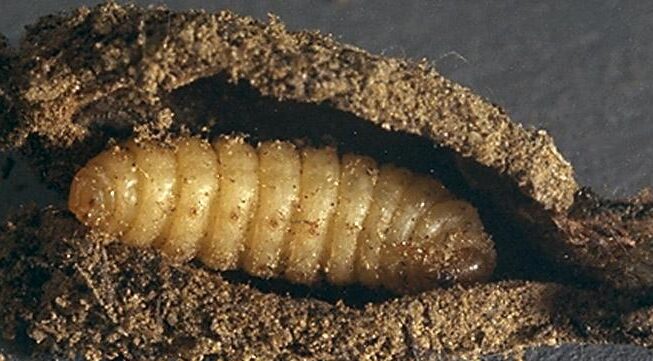
Description:
Root-feeding insects, such as root weevils and beetle larvae, primarily attack the roots of trees. These pests can cause severe damage by feeding on the tree’s roots, which affects its ability to absorb water and nutrients. Root feeders often go unnoticed until the tree shows signs of decline, such as yellowing leaves or stunted growth.
How They Damage Trees:
Root feeders attack the most vital part of a tree – its root system. The larvae of beetles and weevils live underground and feed on the fine roots of the tree, disrupting the absorption of nutrients and water. This damage can lead to reduced growth, poor health, and in severe cases, tree instability, making the tree more susceptible to toppling in high winds.
Signs of Infestation:
- Yellowing or wilting leaves despite sufficient water.
- Poor growth and reduced vigor.
- Tree leaning or instability in the ground.
- Presence of beetles or larvae near the base of the tree.
How to Protect Trees from Root Feeders:
- Regular Monitoring: Keep an eye on tree health and inspect the soil around the base for larvae or beetles.
- Soil Treatments: Apply insecticides like Imidacloprid or beneficial nematodes to the soil to target larvae feeding on the roots.
- Improve Soil Drainage: Root feeders thrive in waterlogged soil, so ensure the tree has proper drainage.
Natural Remedies and Treatments:
- Beneficial Nematodes: These microscopic predators can be introduced into the soil to attack and kill root-feeding larvae.
- Diatomaceous Earth: This natural powder can be applied to the soil to deter and kill root feeders by damaging their exoskeletons.
6. Bark Beetles
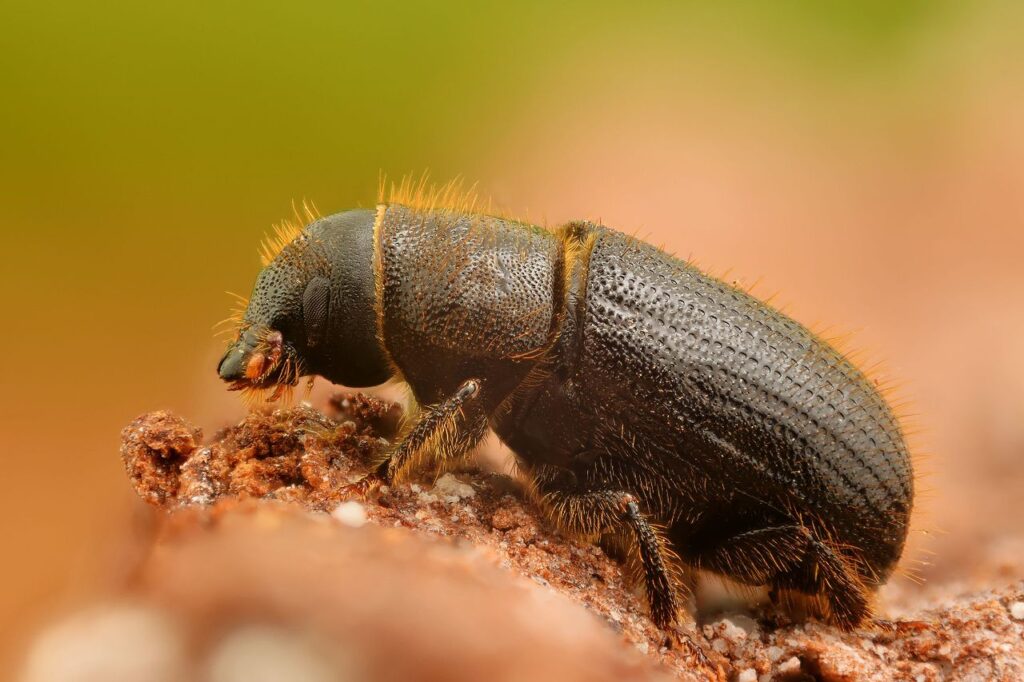
Description:
Bark beetles, including the Mountain Pine Beetle and Southern Pine Beetle, are a group of destructive insects that bore into the bark of trees to lay their eggs. As the larvae develop, they feed on the inner bark, disrupting the tree’s ability to transport water and nutrients.
How They Damage Trees:
Bark beetles are particularly dangerous because they carry fungi that can lead to tree disease, such as blue stain fungus. The combination of physical damage caused by tunneling and the introduction of pathogens can kill trees rapidly. Bark beetles are especially problematic in forests where infestations can spread quickly, killing large swaths
of trees.
Signs of Infestation:
- Small round holes in the bark.
- Sawdust-like material (frass) at the base of the tree.
- Darkening or pitch tubes on the bark.
- Wilting or browning needles and leaves.
How to Protect Trees from Bark Beetles:
- Tree Health: Keep trees healthy through proper watering and mulching, as stressed trees are more susceptible to attack.
- Pheromone Traps: Use traps to monitor and capture adult beetles.
- Insecticides: Apply systemic insecticides like Imidacloprid or Bifenthrin to control infestations.
Natural Remedies and Treatments:
- Bark Peeling: Remove bark in areas of heavy infestation to expose larvae to predators.
- Beneficial Fungi: Some natural fungi, such as Beauveria bassiana, can be applied to kill beetle larvae.
In conclusion, understanding the specific type of insect affecting your trees is crucial to taking the correct action. Regular monitoring, prompt treatment, and maintaining tree health are essential steps to minimize insect damage and preserve the longevity and vitality of your trees.
Damage Caused by Tree Insects
- Structural Weakening: Borers such as the Emerald Ash Borer tunnel through the tree’s inner bark, disrupting nutrient and water flow. This weakens the tree, leading to branch dieback or complete death.
- Defoliation: Leaf chewers like caterpillars and beetles strip the tree of its leaves. Without sufficient leaves, a tree cannot photosynthesize, which leads to poor health and stunted growth.
- Gall Formation: Gall makers cause trees to develop abnormal growths, which can reduce aesthetic value and interfere with nutrient allocation.
- Sap Loss: Sap-sucking insects like aphids drain the tree’s vital nutrients by feeding on sap. This weakens the tree and can make it susceptible to diseases.
- Root Damage: Root feeders weaken the stability of trees, making them more prone to toppling in strong winds or storms.
How to Protect Trees from Insects
Protecting trees from insect damage involves a combination of preventive measures and direct treatments. Here are some effective methods:
- Monitor Regularly: Early detection is crucial. Regularly inspect your trees for signs of insect activity, such as chewed leaves, discolored bark, or sap oozing from the trunk.
- Promote Tree Health: A healthy tree is more resistant to pests. Provide proper watering, mulching, and fertilization to keep trees robust.
- Prune Dead or Infected Parts: Remove any damaged branches or areas affected by pests. Pruning encourages healthy growth and prevents further infestation.
- Natural Predators: Introduce beneficial insects like ladybugs and predatory beetles to control aphid or scale populations.
- Insect Traps: Use pheromone traps to lure and capture specific tree insects, particularly borers and beetles.
- Apply Insecticide: For severe infestations, insecticides may be required. Consult a tree care professional to determine the best product for your situation.
Step-by-Step Guide for Tree Protection
- Step 1: Regular Monitoring
- Conduct regular visual inspections. Look for symptoms like holes in the bark, sawdust-like material at the base, or sticky leaves.
- Step 2: Identify the Insect
- If you notice damage, try to identify the insect. Use online resources or consult with an arborist to determine the exact pest attacking your tree.
- Step 3: Prune Affected Areas
- Remove any branches that show signs of infestation. Dispose of these parts far away from other trees to prevent the spread of insects.
- Step 4: Apply the Appropriate Treatment
- Depending on the insect, use either natural or chemical insecticides. Apply according to the manufacturer’s instructions, and make sure to target both the insect and its larvae.
- Step 5: Introduce Natural Predators
- Release beneficial insects that prey on tree pests. This method is especially effective for sap-sucking insects like aphids.
- Step 6: Mulch and Water
- Maintain tree health by applying mulch around the base of the tree and watering during dry periods. Avoid overwatering, which can attract root-feeding insects.
- Step 7: Use Insect Traps
- Place pheromone traps in areas prone to infestation to catch adult insects before they lay eggs.
Insecticides and Natural Remedies
Insecticides should be used carefully to avoid harming beneficial insects and the environment. Here are some commonly used treatments:
- Chemical Insecticides:
- Imidacloprid: Used for controlling borers and aphids. Effective as a soil drench or tree injection.
- Bifenthrin: Effective against leaf-chewing insects and bark beetles. Applied as a foliar spray.
- Carbaryl: Targets root feeders and leaf chewers.
- Natural Remedies:
- Neem Oil: A natural insecticide that is effective against aphids, scale insects, and caterpillars. It works by disrupting the life cycle of the pests.
- Insecticidal Soap: Safe for the environment, insecticidal soap can be used to suffocate sap-sucking insects like aphids and whiteflies.
- Diatomaceous Earth: Works by damaging the exoskeletons of insects, causing them to dehydrate and die. Suitable for controlling caterpillars and beetles.
10 FAQs about Tree Insects
- What are the most common tree insects?
Common tree insects include aphids, borers (e.g., Emerald Ash Borer), leaf-chewing caterpillars, and sap-sucking insects like scale and whiteflies. - How do borers damage trees?
Borers tunnel into the tree’s bark, disrupting nutrient and water flow, which eventually leads to the weakening and possible death of the tree. - How can I identify an insect infestation in my tree?
Signs of infestation include holes in the bark, sawdust-like material around the base, yellowing or dropping leaves, and the presence of abnormal growths (galls). - What is the best way to prevent insect infestations in trees?
Regular monitoring, maintaining tree health through proper watering and pruning, and introducing natural predators are effective prevention methods. - Are chemical insecticides harmful to trees?
When used correctly, chemical insecticides can effectively control pests without harming trees. However, overuse or incorrect application can damage the tree or the surrounding environment. - How do natural insect predators help control infestations?
Natural predators like ladybugs, lacewings, and parasitic wasps prey on harmful insects like aphids and scale, reducing pest populations. - What should I do if I suspect a root-feeding insect problem?
Root-feeding insects can weaken tree stability. If you suspect a problem, consult an arborist to inspect the roots and apply appropriate treatments, such as insecticides. - Can insect traps completely eliminate a tree pest problem?
While insect traps are effective in capturing adult insects, they are usually best used as part of a broader integrated pest management approach rather than a standalone solution. - How can I naturally protect my trees from sap-sucking insects?
Neem oil, insecticidal soap, and introducing beneficial insects like ladybugs are natural and effective ways to control sap-sucking insects. - Is it possible to save a tree severely infested with borers?
It may be possible to save the tree with early detection and aggressive treatment using systemic insecticides and regular pruning, but severe infestations can sometimes lead to the loss of the tree.
Conclusion
Tree insects pose a serious threat to the health and beauty of trees, but with proper care and timely intervention, infestations can be managed or prevented altogether. By using a combination of regular monitoring, natural and chemical treatments, and promoting tree health, you can protect your trees from the harmful effects of these pests. Whether you choose chemical insecticides or natural remedies, a proactive approach is key to keeping your trees healthy and thriving for years to come.
